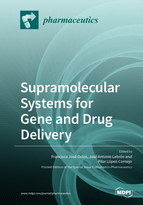Supramolecular Systems for Gene and Drug Delivery
A special issue of Pharmaceutics (ISSN 1999-4923). This special issue belongs to the section "Drug Delivery and Controlled Release".
Deadline for manuscript submissions: closed (25 November 2021) | Viewed by 31374
Special Issue Editors
Interests: DNA; calixarenes; liposomes; drugs; micelles; vesicles; nanovehicles; nanoparticles
Special Issues, Collections and Topics in MDPI journals
Interests: surfactants; nanoparticles; micelles; liposome; drug delivery
Special Issues, Collections and Topics in MDPI journals
Interests: nanomaterials; polymers; physical chemistry; Kinetics; thermodynamics; carbon nanotubes; DNA; gene therapy; micelles; liposomes; nanoparticles; dendrimers; surfactants
Special Issues, Collections and Topics in MDPI journals
Special Issue Information
Dear Colleagues,
Supramolecular systems (calixarenes, cyclodextrins, polymers, peptides, etc.) have attracted special attention due to their excellent therapeutic properties for biomedical applications such as gene and drug delivery. Numerous biomaterials-based supramolecular systems have been developed in the last decade for enhancing of biocompatibility and pharmacological activity. In particular, supramolecular nanomaterials are considered a hot research topic, because nanomedicine has become an interesting tool for the treatment of genetic diseases or cancer. Nevertheless, novel systems and their properties are being continuously studied, contributing to the development of efficient delivery systems.
This Special Issue provides and highlights current progress in the use of the supramolecular systems for boosting gene and drug delivery. Preparation, characterization, and use of these systems, as well as the latest developments in this research field, are especially welcome.
Authors are encorauged to submit original research articles and reviews in this promising research field.
Dr. Francisco José Ostos
Dr. José Antonio Lebrón
Prof. Dr. Pilar López-Cornejo
Guest Editors
Manuscript Submission Information
Manuscripts should be submitted online at www.mdpi.com by registering and logging in to this website. Once you are registered, click here to go to the submission form. Manuscripts can be submitted until the deadline. All submissions that pass pre-check are peer-reviewed. Accepted papers will be published continuously in the journal (as soon as accepted) and will be listed together on the special issue website. Research articles, review articles as well as short communications are invited. For planned papers, a title and short abstract (about 100 words) can be sent to the Editorial Office for announcement on this website.
Submitted manuscripts should not have been published previously, nor be under consideration for publication elsewhere (except conference proceedings papers). All manuscripts are thoroughly refereed through a single-blind peer-review process. A guide for authors and other relevant information for submission of manuscripts is available on the Instructions for Authors page. Pharmaceutics is an international peer-reviewed open access monthly journal published by MDPI.
Please visit the Instructions for Authors page before submitting a manuscript. The Article Processing Charge (APC) for publication in this open access journal is 2900 CHF (Swiss Francs). Submitted papers should be well formatted and use good English. Authors may use MDPI's English editing service prior to publication or during author revisions.
Keywords
- supramolecular materials
- gene and drug delivery systems
- nanomaterials
- controlled release
- drug targeting
- polymers
- peptides
- macrocycles









